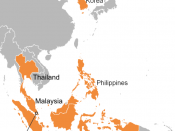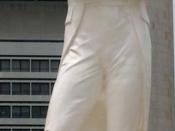Singapore is a small nation state located at the southern tip of the Malayan Peninsula. It was founded by Sir Stamford Raffles in 1819 as part of the British colonial empire. Due to its strategic location, astride the sea routes from Europe and India to China and Japan, the British developed Singapore as a free port and centre for entrepot trade i.e. goods are imported from one country and exported to another (Hamilton, 1996, p. 134). The structure of the economy was then developed as an open economy. The objective of this essay is to discuss Singapore's economy as an open one with the influence of the PAP in it and the extent of the economic development model of Singapore.
The PAP was formed on 21 November 1954 at the Victoria Memorial Hall in Singapore. The founding leadership represented three distinct groups: the social democrats, consisting mostly of English - educated professionals; leaders of public service unions; and pro-communists, representing unions in the private sector and Chinese school teachers (Vasil, 2000, p.
19). The PAP now views itself as the sole custodian of the Singapore nation. At first, Singapore followed an inward - looking development, and then it open up the country to foreign investment and multinationals with attractive fiscal incentives. The PAP now has adopted the policy of mixed economy (Islam and Chowdhury, 1997, p. 197).
Singapore's government assumes itself as an instrument in shaping and managing the economic environment and it underscores the importance of identifying and investing in certain key capabilities (Ohmae, 1995, p. 67). The government gradually shifted investment incentives toward more sophisticated, capital - intensive industries (Ohmae, 1995, p. 73). Singapore's financial system is very stable one. This is because the government routinely accumulates a budget surplus and has accumulated substantial foreign reserves. Singapore...


